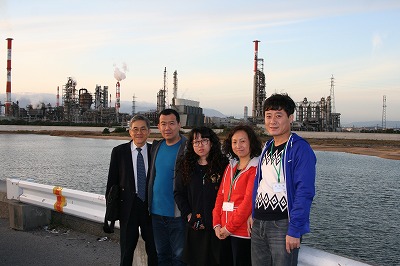Home > Workshop and Training > IN JAPAN > Fiscal Year 2015 > FY2015 Capacity Building Course Held for Tianjin, China
Main content starts here.
Update:September 9, 2016
FY2015 Capacity Building Course Held for Tianjin, China
The International Center for Environmental Technology Transfer, ICETT, carried out a Yokkaichi-commissioned training course for officials from the Environment Protection Bureau of Tianjin, China, and relevant Chinese organizations.
ICETT would like to express its gratitude to the lecturers, company staff, and local government officials for their cordial cooperation and support for the course.
1) Duration
November 16 (Mon.) to December 1 (Tues.), 2015
2) Participants
Four officials from the Environment Protection Bureau of the City of Tianjin, China, and relevant Chinese organizations
3) Outline
This course on air pollution control measures and technology, which was also the theme of a seminar held in Tianjin earlier, provided an opportunity for the Chinese participants to learn about efforts made against pollution in Japan and useful environmental technology. The aim of the course was to help the participants start contributing to improving air quality in Tianjin, while offering them knowledge and knowhow regarding measures for air pollution control.
The participants took lectures at ICETT on the so-called Yokkaichi pollution and visited the Yokkaichi Pollution and Environmental Museum for Future Awareness, which opened in March 2015. They learned about the history of the City of Yokkaichi and the historical background of the Yokkaichi pollution.

(Lecture scene at ICETT)
The participants also visited the Yokkaichi municipal and Mie prefectural governments and companies in petrochemical complexes in Yokkaichi. They made observations and took lectures there from past, current, and future viewpoints.

(In the Isozu area, the original source of the Yokkaichi pollution)
The participants also visited a major auto plant and other facilities in Kobe and other cities to learn about various aspects of mobile emission sources and environmental management methods used by large businesses. The course included some other visits to facilities at Yokkaichi Port and a local industries exhibition.

(Viewing Yokkaichi from the observation gallery of Yokkaichi Port Building)
There were comments from the participants as follows: “I would like to make use of Japan’s rich experiences and advanced models and make efforts to tackle and solve problems regarding automobile pollution, the greatest technical issues of my country.”, “I learned quite a lot about environmental protection measures at chemical works, environmental measures in Yokkaichi and Kobe, and air quality improvement measures concerning mobile emission sources, which are exactly what I have been working on back in my country. This course provided very concrete and useful contents and my country’s significant problems became clear to me.”, “Tianjin is a typical industrial city and is now confronted mainly with air pollution issues. It is the most interesting matter for those engaged in environmental conservation to examine and learn about how to effectively control air pollution. So, this course was a good opportunity to do that.”, and “I felt it’s very important to actually visit the relevant sites. There was also an opportunity to talk with staff and engineers at factories, giving me an opportunity to learn a lot.”
The Environment Protection Bureau of the City of Tianjin provided ICETT with full cooperation in selecting the participants, giving advance information to them, and writing job reports.
This course took place on the sidelines of an environmental protection seminar in Tianjin. It is also highly expected to offer fulfilling contents to serve as foundation for Yokkaichi-Tianjin friendships and help contribute to environmental improvement in the future.

(Commemorative photo after the course)







